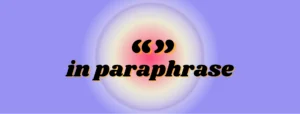Paraphrasing is a fundamental skill in academic writing, especially when adhering to specific citation styles like APA (American Psychological Association). In this article, we will explore the nuances of paraphrasing in APA, understand the distinction between citations and paraphrases, and uncover valuable tips to ensure your paraphrased content is not flagged as plagiarism.

✅ AI Essay Writer ✅ AI Detector ✅ Plagchecker ✅ Paraphraser
✅ Summarizer ✅ Citation Generator
What Is APA Citation Style?
APA citation style is widely used in various academic disciplines, including psychology, social sciences, and education. It provides a standardized format for citing sources in research papers, ensuring consistency, credibility, and ease of comprehension for readers. Proper APA citation style is essential for acknowledging the work of others and avoiding plagiarism.

What Is the Difference Between a Citation and a Paraphrase?
Citations and paraphrases serve distinct purposes in academic writing. A citation is a direct reference to a source, providing readers with the exact location of the quoted or paraphrased material. In contrast, a paraphrase involves restating someone else’s ideas or information in your own words, preserving the original meaning while avoiding verbatim repetition.
How to Paraphrase in APA Examples
Let’s look at several APA paraphrasing examples to know exactly what we’ve dealing with.
Examples of Citing Paraphrased Information in APA at the Beginning of a Sentence
| Paraphrased Information at the Beginning of a Sentence | Description |
|---|---|
| According to Williams (2021), an extensive examination of climate change was undertaken. | In this example, the author’s name, Williams, is mentioned in the text itself, followed by the publication year in parentheses. |
| The global impact of climate change is a matter of great concern (Terrence, 2019). | Here, the author’s name and publication year are enclosed in parentheses at the end of the paraphrased sentence. |
| Immediate action is underscored in climate change research (Smith & Johnson, 2023). | In this case, two authors, Smith and Johnson, are cited within the parentheses, representing a paraphrased statement from their research. |
This is one way to paraphrase your information using the APA style. Let’s see some others.
Examples of Citing Paraphrased Information in APA in the Middle of a Sentence
| Sentence with Paraphrased Information and Citation | Description |
|---|---|
| Recent studies (Webkin, 2022) have shown a significant decline in biodiversity. | In this example, the author’s last name, Webkin, and the publication year, 2022, are integrated into the middle of the sentence, providing context for the research. |
| The impact of technology on daily life has been extensively explored (Gregson & Lee, 2019). | Here, two authors, Gregson and Lee, are cited within the sentence, emphasizing the significance of their research within the context of the sentence. |
| According to recent findings (Diaz et al., 2021), the link between stress and health outcomes is well-established. | In this case, multiple authors are represented by “Diaz et al.” in the middle of the sentence, indicating the collective research effort. |
Another way to cite your sources is to mention them at the end of the sentence.
| Sentence with Paraphrased Information and Citation | Description |
|---|---|
| The impact of climate change on coastal ecosystems is evident (Scholtz, 2018). | In this example, the author’s last name, Scholtz, and the publication year, 2018, are placed at the end of the sentence to attribute the information. |
| Social media has transformed communication patterns (Oishi & Serene, 2021). | Here, two authors, Oishi and Serene, are cited at the sentence’s end, acknowledging their research’s contribution to the statement. |
| The role of genetics in human behavior has been extensively researched (Sandy et al., 2020). | In this case, multiple authors are represented by “Sandy et al.” at the end of the sentence, crediting their collective work. |
Here’s how you can paraphrase the original information into your work without it being considered plagiarism.
Original text:
The complexity of disaster experience calls for considerations at many different levels of inquiry: environmental, psychological, social, political, and cultural. Yet, the crux of disaster experience is the dynamic interplay of environmental challenges and losses embedded within collective processes of mutual exchanges of aid and support. Hence, the featured research findings are organized along the three most distinct operational facets of an all-embracing construct of social support: received social support (e.g. ‘being actually helped by others in times of need’), perceived social support (e.g. ‘subjective appraisals of being reliably connected to others’), and social embeddedness(e.g. ‘types and frequency of interpersonal and community connections’).
Source: Kaniasty, K. (2019). Social support, interpersonal, and community dynamics following disasters caused by natural hazards. Current Opinion in Psychology. doi:10.1016/j.copsyc.2019.07.026

Tips for Correct Paraphrasing
Effective paraphrasing not only demonstrates your understanding of the source material but also safeguards against plagiarism. Here are essential tips to master the art of paraphrasing in APA.

Before embarking on the paraphrasing journey, it is crucial to have a deep understanding of the source material. Delve into the text, dissecting complex ideas and concepts. Simplify intricate passages in your mind to grasp the core message. This comprehension forms the foundation of effective paraphrasing.
Paraphrasing involves substituting words with synonyms and reorganizing sentence structure while retaining the original meaning. A thesaurus can be a valuable tool in finding appropriate synonyms. By reshaping sentences and words creatively, you can convey the same information without copying the source verbatim.
While rephrasing, the core idea and intention of the source must remain intact. It is essential to preserve the author’s message and avoid any distortions. Ensure that your paraphrase accurately reflects the source’s meaning, providing a fresh perspective without altering the content’s essence.
Even in the process of paraphrasing, always acknowledge the source. In-text citations following APA guidelines are necessary. Include the author’s last name and the publication year to provide clear attribution. This practice not only maintains academic integrity but also allows readers to trace the original source.
Utilize plagiarism detection tools as a final step to verify your paraphrased content. These tools help ensure that your paraphrased text does not unintentionally resemble the original source too closely. Thoroughly checking for similarities and making necessary adjustments guarantees that your work remains free from plagiarism concerns.
Conclusion
Paraphrasing in APA is an essential skill for any student or researcher. By understanding the intricacies of APA citation style, distinguishing between citations and paraphrases, and following our tips for correct paraphrasing, you can ensure your academic work is both credible and free from plagiarism. Mastering this skill empowers you to incorporate the ideas of others seamlessly while maintaining the integrity of your own writing.
FAQ
Follow us on Reddit for more insights and updates.





Comments (0)
Welcome to A*Help comments!
We’re all about debate and discussion at A*Help.
We value the diverse opinions of users, so you may find points of view that you don’t agree with. And that’s cool. However, there are certain things we’re not OK with: attempts to manipulate our data in any way, for example, or the posting of discriminative, offensive, hateful, or disparaging material.